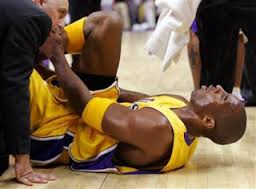 The separation between talent and skill is one of the greatest misunderstood concepts for people who are trying to excel.
The separation between talent and skill is one of the greatest misunderstood concepts for people who are trying to excel.
In life and in sports.
Either way, talent is natural. You either have it or you don’t.
Skill is different. Skill can only be developed by hours and hours of working on your craft.
Hours. And hours. And hours.
Kobe Bryant knows those hours (and hours and hours) very well. It’s why, at the tender age of 35, he is still considered one of the best players in the NBA. One of the guys that you know is worth the price of admission, capable of any feat, any highlight on any given night.
But that’s exactly it. Bryant is 35. And for the first time in his illustrious 17-year career, he is missing out on those invaluable hours. Sure, he’ll rack up the hours, the minutes and the miles over the course of this upcoming season when he returns from a torn Achilles, but Kobe Bryant did not become Kobe Bryant during the regular season.
He became Kobe Bryant during the offseason. Ken Berger of CBSSports has the story: “The latest on Kobe Bryant is that he may miss all of preseason as he continues to push through his rehab and recovery following surgery to repair a ruptured left Achilles’ tendon. That’s the latest, but it isn’t really the news. What’s important about this particular dose of Kobe news — a statement from the Lakers that he is “progressing well” but that there is no timetable for his return to the court — has nothing to do, really, with that Achilles’ tendon. It has to do with the rest of his body. Let me explain.”
As with any tendon injury, the rupture is repaired surgically and the tendon needs time to heal. Bryant, being a world-class athlete and a conditioning marvel of the modern sports era, will recover from that injury. Even at 35, his tendon will heal, the surrounding tissue will repair itself, and Bryant gradually will return to full, weight-bearing athletic activity involving a basketball and a hoop, as he has been doing for his entire adult life.
But what about the rest of him? That’s where the focus should be as Bryant makes the transition from rehab and recovery to strength and conditioning, and ultimately, to on-court performance.
Berger makes an excellent point: for the first time in Bryant’s career, he will not have undergone the rigorous summer conditioning that has propelled him to greatness year after year after year. He references a quote from Lakers’ spokesman, John Black:
“One of the key issues is to make sure he builds up strength and endurance not only in his Achilles but also in his legs, knees, back and core.”
How is Bryant supposed to do this, at the all-world level that he is accustomed too, if he is rehabbing from a torn Achilles?
Simply put, he can’t.
Berger uses Derek Jeter as a comparison. Although Jeter is a baseball player, suffered a different injury and is four years older, one relevant commonality can be drawn between the two future Hall of Famers.
Like Bryant, Jeter spent last offseason rehabbing a severe ankle injury. He missed out on the hours and hours of preparation that normally condition him for greatness. At the age of 25 that may not be as big of a problem. Younger players heal faster.
But at 39?
Jeter didn’t stand a chance. He barely lasted 20 games before he was sidelined again.
So what does this mean for Bryant at age 35?
Bear in mind that the hallmark of Bryant’s longevity has been a maniacal commitment to offseason strength and conditioning work. Bryant logged more than 54,000 minutes of regular season and playoff basketball before suffering a career-altering injury for a reason.
He has spoken sparingly throughout his career about his training regimen; trainer Tim Grover has given more detail than Bryant ever has in his book, “Relentless.” But in this 2012 interview with Men’s Fitness, Bryant divulged some of his secrets: Olympic weightlifting, sprinting and a will to push through pain and fatigue that most humans couldn’t fathom.
And from the Black Mamba himself:
“Whatever your program is, the key is to push yourself to a level where you’re hurting,” Bryant said. “You can’t gain conditioning without going through it. You’re going to have to feel some pain, you’re going to have to feel like your lungs are burning, and you know, you want to spit up blood, that sort of thing.”
The question is not if Kobe Bryant will play basketball this season.
Because he will. He will run, dribble, pass (occasionally), shoot and score just like he always has.
The question is for how long.
Onto more news from around the NBA
Ben, as enjoyable as your article about Kobe’s outlook was to read, it contains one glaring omission. Kobe HAS gone through a summer where he didn’t concentrate on honing his basketball skills. That was the summer preceded by his knee surgery and his problems with the woman at the hotel in Colorado.
Yes, he didn’t have a wonderful season (by his standards) that fall, but he was distracted by his constant trips to Colorado for legal proceedings in addition to problems he encountered with his knee. He may well get off to a slow start this season, whenever he begins playing. But he’s been through this before, contrary to the point that you made in your otherwise well-presented article about Kobe’s legendary conditioning routine.
Robert,
I appreciate the revision. You know, it seems so long ago that Kobe was going through that. Even if we do think all the way back, it is hard to remember that Kobe even had a knee issue as that period was dominated by his scandal. Great memory and appreciate the read.